UBLMCG-15-M09024425: Real Estate Law - UK Rent Review Advantage?
VerifiedAdded on 2019/09/20
|12
|5766
|558
Essay
AI Summary
This discursive essay examines UK rent reviews within the context of real estate law, specifically addressing whether they represent an advantage for landlords. It begins by outlining the historical development of rent reviews in the UK and relevant case law, focusing on the procedures for serving rent review notices, the review valuation process, and the prevalence of upward-only rent reviews. The essay analyzes these aspects to assess their impact on landlords and tenants, considering the evolution of lease agreements, the influence of inflation, and the development of codes of practice. The analysis includes a discussion of key legal cases and government interventions, such as the Landlord and Tenant Act 1954 and various codes of practice, to evaluate whether UK rent reviews, despite appearing preferential to landlords at first glance, ultimately offer equal opportunity to both parties, particularly given the freedom to negotiate lease terms. The essay considers alternative rent review mechanisms and the arguments for and against upward-only rent reviews to provide a comprehensive understanding of the topic.
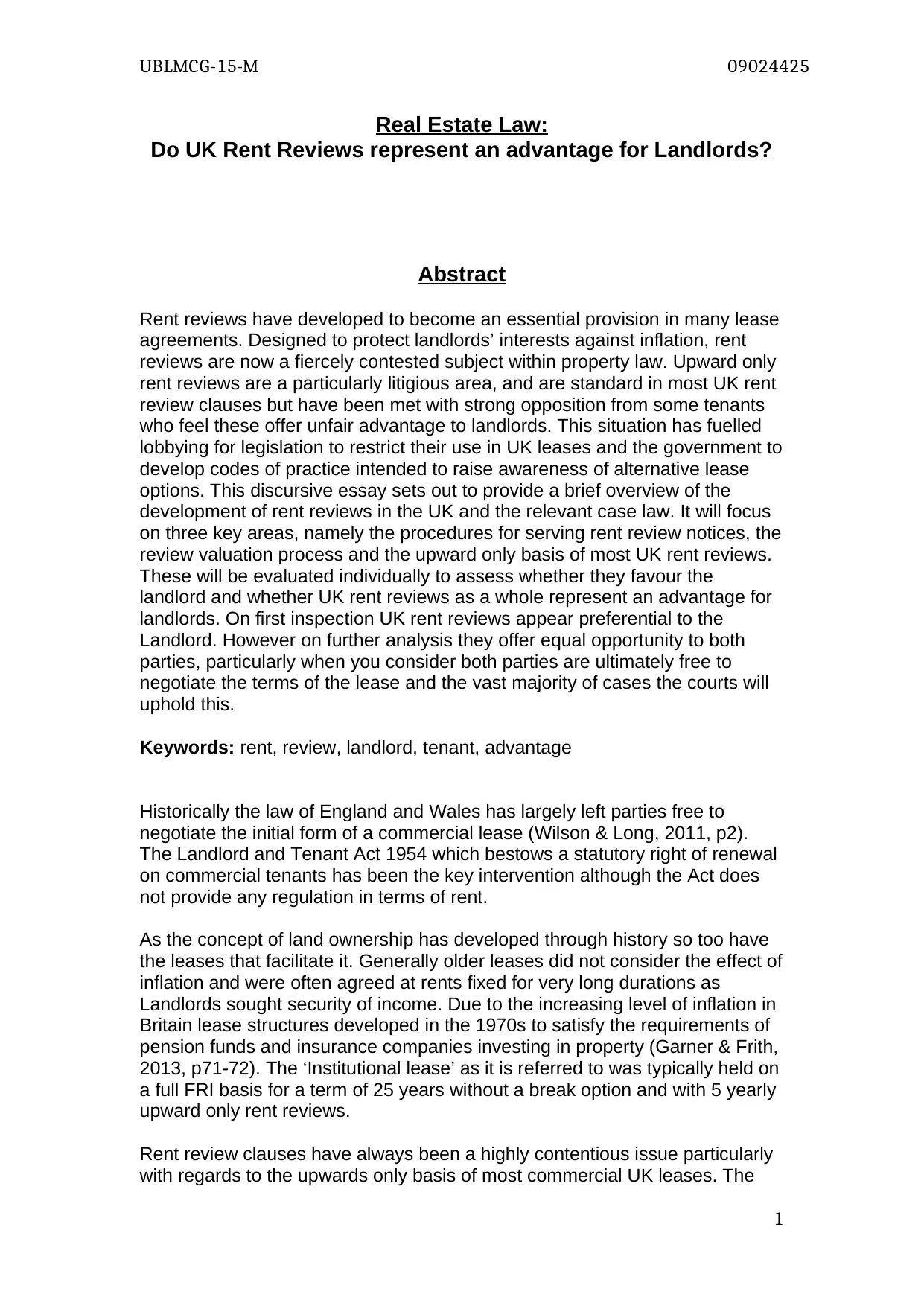
UBLMCG-15-M 09024425
Real Estate Law:
Do UK Rent Reviews represent an advantage for Landlords?
Abstract
Rent reviews have developed to become an essential provision in many lease
agreements. Designed to protect landlords’ interests against inflation, rent
reviews are now a fiercely contested subject within property law. Upward only
rent reviews are a particularly litigious area, and are standard in most UK rent
review clauses but have been met with strong opposition from some tenants
who feel these offer unfair advantage to landlords. This situation has fuelled
lobbying for legislation to restrict their use in UK leases and the government to
develop codes of practice intended to raise awareness of alternative lease
options. This discursive essay sets out to provide a brief overview of the
development of rent reviews in the UK and the relevant case law. It will focus
on three key areas, namely the procedures for serving rent review notices, the
review valuation process and the upward only basis of most UK rent reviews.
These will be evaluated individually to assess whether they favour the
landlord and whether UK rent reviews as a whole represent an advantage for
landlords. On first inspection UK rent reviews appear preferential to the
Landlord. However on further analysis they offer equal opportunity to both
parties, particularly when you consider both parties are ultimately free to
negotiate the terms of the lease and the vast majority of cases the courts will
uphold this.
Keywords: rent, review, landlord, tenant, advantage
Historically the law of England and Wales has largely left parties free to
negotiate the initial form of a commercial lease (Wilson & Long, 2011, p2).
The Landlord and Tenant Act 1954 which bestows a statutory right of renewal
on commercial tenants has been the key intervention although the Act does
not provide any regulation in terms of rent.
As the concept of land ownership has developed through history so too have
the leases that facilitate it. Generally older leases did not consider the effect of
inflation and were often agreed at rents fixed for very long durations as
Landlords sought security of income. Due to the increasing level of inflation in
Britain lease structures developed in the 1970s to satisfy the requirements of
pension funds and insurance companies investing in property (Garner & Frith,
2013, p71-72). The ‘Institutional lease’ as it is referred to was typically held on
a full FRI basis for a term of 25 years without a break option and with 5 yearly
upward only rent reviews.
Rent review clauses have always been a highly contentious issue particularly
with regards to the upwards only basis of most commercial UK leases. The
1
Real Estate Law:
Do UK Rent Reviews represent an advantage for Landlords?
Abstract
Rent reviews have developed to become an essential provision in many lease
agreements. Designed to protect landlords’ interests against inflation, rent
reviews are now a fiercely contested subject within property law. Upward only
rent reviews are a particularly litigious area, and are standard in most UK rent
review clauses but have been met with strong opposition from some tenants
who feel these offer unfair advantage to landlords. This situation has fuelled
lobbying for legislation to restrict their use in UK leases and the government to
develop codes of practice intended to raise awareness of alternative lease
options. This discursive essay sets out to provide a brief overview of the
development of rent reviews in the UK and the relevant case law. It will focus
on three key areas, namely the procedures for serving rent review notices, the
review valuation process and the upward only basis of most UK rent reviews.
These will be evaluated individually to assess whether they favour the
landlord and whether UK rent reviews as a whole represent an advantage for
landlords. On first inspection UK rent reviews appear preferential to the
Landlord. However on further analysis they offer equal opportunity to both
parties, particularly when you consider both parties are ultimately free to
negotiate the terms of the lease and the vast majority of cases the courts will
uphold this.
Keywords: rent, review, landlord, tenant, advantage
Historically the law of England and Wales has largely left parties free to
negotiate the initial form of a commercial lease (Wilson & Long, 2011, p2).
The Landlord and Tenant Act 1954 which bestows a statutory right of renewal
on commercial tenants has been the key intervention although the Act does
not provide any regulation in terms of rent.
As the concept of land ownership has developed through history so too have
the leases that facilitate it. Generally older leases did not consider the effect of
inflation and were often agreed at rents fixed for very long durations as
Landlords sought security of income. Due to the increasing level of inflation in
Britain lease structures developed in the 1970s to satisfy the requirements of
pension funds and insurance companies investing in property (Garner & Frith,
2013, p71-72). The ‘Institutional lease’ as it is referred to was typically held on
a full FRI basis for a term of 25 years without a break option and with 5 yearly
upward only rent reviews.
Rent review clauses have always been a highly contentious issue particularly
with regards to the upwards only basis of most commercial UK leases. The
1
Paraphrase This Document
Need a fresh take? Get an instant paraphrase of this document with our AI Paraphraser

UBLMCG-15-M 09024425
significant variety of rent review provisions has prompted litigation over the
interpretation of rent review clauses despite an extensive volume of existing
case law on the subject (Gatty, 2005). The recent structural shift towards
shorter leases has seen a decrease in the occurrence of rent reviews
(BPF/IPD, 2007, p3). However, Loveday et al. report there is no evidence of
an accompanying decrease in the number of disputes (2008, p11). Disputes
principally centre on the pattern of the review, the review valuation process
and the serving of notices.
A Rent review clause is a clause inserted into lease agreements to “allow the
periodical adjustment of commercial rents to the market level current at the
date of review” (RICS, 2014). In the UK rent review clauses vary considerably
and although no specific wording is required they tend to place certain
obligations on the parties concerned, such as requiring a rent review at stated
intervals. The new rent payable after the review is stipulated as that which the
landlord might reasonably expect to obtain on the open market if he were to
re-let the premises on the review date. They are typically not geared to an
index and specify that the rent may be reviewed upwards only (Wilson &
Long, 2014, p2).
A well-drafted rent review clause will clearly specify the dates on which the
rent shall be reviewed, the machinery for the review, the basis of the revised
rental valuation, the process to trigger the review as well as the resolution
procedure if the landlord and tenant fail to negotiate independently (RICS,
2014). Although the basic form for the contract is relatively simple, differences
of interpretation due to inconsistent drafting have resulted in a sizable body of
landlord and tenant case law (Baum & Crosby, 1995, 112).
The purpose of a rent review is to give the landlord protection against inflation
when property values increase by raising the rent in line with market rental
figures (Card et al., 2003). Most rent reviews in UK leases are on an upwards
only basis that also protects the landlord against falls in property prices by
retaining the previous rental value. Upward only rent reviews require that if the
open market rental figure is in excess of the passing rent at the time of the
review, this will become the new rent payable for the following period
(Loveday et al., 2008, p63). Machinery that allows the landlord to trigger the
rent review exclusively may have the same effect as an upward only rent
review, as a suitably informed landlord will not trigger the review if the market
rent is less than the passing rent.
The case of Hemingway Realty v Clothworkers Guild [2005] EWHC 299
concerned a tenant contending the right to review the rent with the landlord
refusing to review the rent as the market rent was less than the rent payable.
Royal Insurance Property Services v Cliffway [1996] also involved a tenant
seeking to initiate a rent review, this time on the basis that a memorandum
postdating the lease provides for upward and downward rent reviews. The
judgment of Rattee J in dismissing the case reinforced the importance of the
wording of leases. The majority of UK leases have rent review clauses
exercisable by the landlord only, existing case law seems to further
strengthen this position to the detriment of the tenant.
2
significant variety of rent review provisions has prompted litigation over the
interpretation of rent review clauses despite an extensive volume of existing
case law on the subject (Gatty, 2005). The recent structural shift towards
shorter leases has seen a decrease in the occurrence of rent reviews
(BPF/IPD, 2007, p3). However, Loveday et al. report there is no evidence of
an accompanying decrease in the number of disputes (2008, p11). Disputes
principally centre on the pattern of the review, the review valuation process
and the serving of notices.
A Rent review clause is a clause inserted into lease agreements to “allow the
periodical adjustment of commercial rents to the market level current at the
date of review” (RICS, 2014). In the UK rent review clauses vary considerably
and although no specific wording is required they tend to place certain
obligations on the parties concerned, such as requiring a rent review at stated
intervals. The new rent payable after the review is stipulated as that which the
landlord might reasonably expect to obtain on the open market if he were to
re-let the premises on the review date. They are typically not geared to an
index and specify that the rent may be reviewed upwards only (Wilson &
Long, 2014, p2).
A well-drafted rent review clause will clearly specify the dates on which the
rent shall be reviewed, the machinery for the review, the basis of the revised
rental valuation, the process to trigger the review as well as the resolution
procedure if the landlord and tenant fail to negotiate independently (RICS,
2014). Although the basic form for the contract is relatively simple, differences
of interpretation due to inconsistent drafting have resulted in a sizable body of
landlord and tenant case law (Baum & Crosby, 1995, 112).
The purpose of a rent review is to give the landlord protection against inflation
when property values increase by raising the rent in line with market rental
figures (Card et al., 2003). Most rent reviews in UK leases are on an upwards
only basis that also protects the landlord against falls in property prices by
retaining the previous rental value. Upward only rent reviews require that if the
open market rental figure is in excess of the passing rent at the time of the
review, this will become the new rent payable for the following period
(Loveday et al., 2008, p63). Machinery that allows the landlord to trigger the
rent review exclusively may have the same effect as an upward only rent
review, as a suitably informed landlord will not trigger the review if the market
rent is less than the passing rent.
The case of Hemingway Realty v Clothworkers Guild [2005] EWHC 299
concerned a tenant contending the right to review the rent with the landlord
refusing to review the rent as the market rent was less than the rent payable.
Royal Insurance Property Services v Cliffway [1996] also involved a tenant
seeking to initiate a rent review, this time on the basis that a memorandum
postdating the lease provides for upward and downward rent reviews. The
judgment of Rattee J in dismissing the case reinforced the importance of the
wording of leases. The majority of UK leases have rent review clauses
exercisable by the landlord only, existing case law seems to further
strengthen this position to the detriment of the tenant.
2
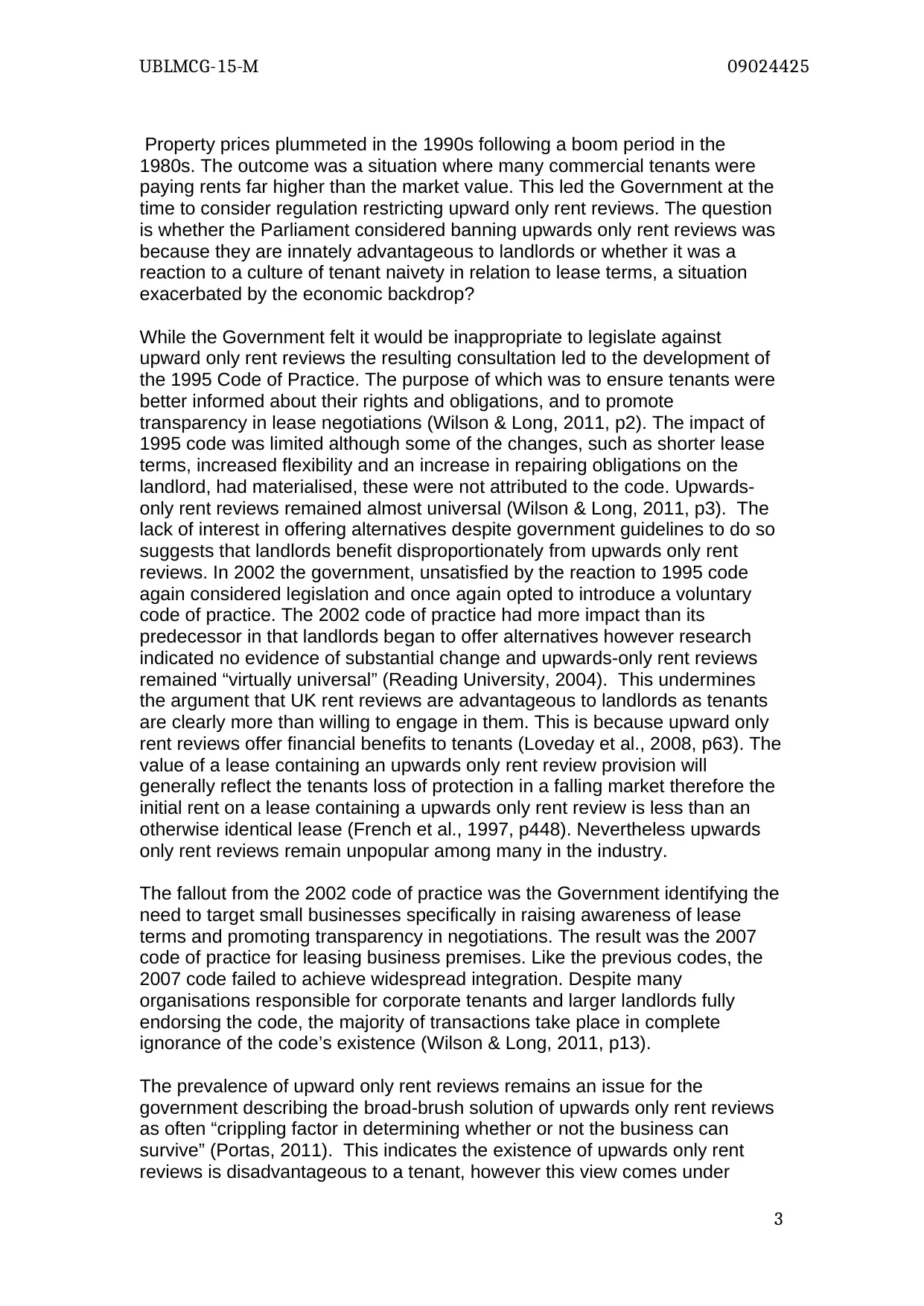
UBLMCG-15-M 09024425
Property prices plummeted in the 1990s following a boom period in the
1980s. The outcome was a situation where many commercial tenants were
paying rents far higher than the market value. This led the Government at the
time to consider regulation restricting upward only rent reviews. The question
is whether the Parliament considered banning upwards only rent reviews was
because they are innately advantageous to landlords or whether it was a
reaction to a culture of tenant naivety in relation to lease terms, a situation
exacerbated by the economic backdrop?
While the Government felt it would be inappropriate to legislate against
upward only rent reviews the resulting consultation led to the development of
the 1995 Code of Practice. The purpose of which was to ensure tenants were
better informed about their rights and obligations, and to promote
transparency in lease negotiations (Wilson & Long, 2011, p2). The impact of
1995 code was limited although some of the changes, such as shorter lease
terms, increased flexibility and an increase in repairing obligations on the
landlord, had materialised, these were not attributed to the code. Upwards-
only rent reviews remained almost universal (Wilson & Long, 2011, p3). The
lack of interest in offering alternatives despite government guidelines to do so
suggests that landlords benefit disproportionately from upwards only rent
reviews. In 2002 the government, unsatisfied by the reaction to 1995 code
again considered legislation and once again opted to introduce a voluntary
code of practice. The 2002 code of practice had more impact than its
predecessor in that landlords began to offer alternatives however research
indicated no evidence of substantial change and upwards-only rent reviews
remained “virtually universal” (Reading University, 2004). This undermines
the argument that UK rent reviews are advantageous to landlords as tenants
are clearly more than willing to engage in them. This is because upward only
rent reviews offer financial benefits to tenants (Loveday et al., 2008, p63). The
value of a lease containing an upwards only rent review provision will
generally reflect the tenants loss of protection in a falling market therefore the
initial rent on a lease containing a upwards only rent review is less than an
otherwise identical lease (French et al., 1997, p448). Nevertheless upwards
only rent reviews remain unpopular among many in the industry.
The fallout from the 2002 code of practice was the Government identifying the
need to target small businesses specifically in raising awareness of lease
terms and promoting transparency in negotiations. The result was the 2007
code of practice for leasing business premises. Like the previous codes, the
2007 code failed to achieve widespread integration. Despite many
organisations responsible for corporate tenants and larger landlords fully
endorsing the code, the majority of transactions take place in complete
ignorance of the code’s existence (Wilson & Long, 2011, p13).
The prevalence of upward only rent reviews remains an issue for the
government describing the broad-brush solution of upwards only rent reviews
as often “crippling factor in determining whether or not the business can
survive” (Portas, 2011). This indicates the existence of upwards only rent
reviews is disadvantageous to a tenant, however this view comes under
3
Property prices plummeted in the 1990s following a boom period in the
1980s. The outcome was a situation where many commercial tenants were
paying rents far higher than the market value. This led the Government at the
time to consider regulation restricting upward only rent reviews. The question
is whether the Parliament considered banning upwards only rent reviews was
because they are innately advantageous to landlords or whether it was a
reaction to a culture of tenant naivety in relation to lease terms, a situation
exacerbated by the economic backdrop?
While the Government felt it would be inappropriate to legislate against
upward only rent reviews the resulting consultation led to the development of
the 1995 Code of Practice. The purpose of which was to ensure tenants were
better informed about their rights and obligations, and to promote
transparency in lease negotiations (Wilson & Long, 2011, p2). The impact of
1995 code was limited although some of the changes, such as shorter lease
terms, increased flexibility and an increase in repairing obligations on the
landlord, had materialised, these were not attributed to the code. Upwards-
only rent reviews remained almost universal (Wilson & Long, 2011, p3). The
lack of interest in offering alternatives despite government guidelines to do so
suggests that landlords benefit disproportionately from upwards only rent
reviews. In 2002 the government, unsatisfied by the reaction to 1995 code
again considered legislation and once again opted to introduce a voluntary
code of practice. The 2002 code of practice had more impact than its
predecessor in that landlords began to offer alternatives however research
indicated no evidence of substantial change and upwards-only rent reviews
remained “virtually universal” (Reading University, 2004). This undermines
the argument that UK rent reviews are advantageous to landlords as tenants
are clearly more than willing to engage in them. This is because upward only
rent reviews offer financial benefits to tenants (Loveday et al., 2008, p63). The
value of a lease containing an upwards only rent review provision will
generally reflect the tenants loss of protection in a falling market therefore the
initial rent on a lease containing a upwards only rent review is less than an
otherwise identical lease (French et al., 1997, p448). Nevertheless upwards
only rent reviews remain unpopular among many in the industry.
The fallout from the 2002 code of practice was the Government identifying the
need to target small businesses specifically in raising awareness of lease
terms and promoting transparency in negotiations. The result was the 2007
code of practice for leasing business premises. Like the previous codes, the
2007 code failed to achieve widespread integration. Despite many
organisations responsible for corporate tenants and larger landlords fully
endorsing the code, the majority of transactions take place in complete
ignorance of the code’s existence (Wilson & Long, 2011, p13).
The prevalence of upward only rent reviews remains an issue for the
government describing the broad-brush solution of upwards only rent reviews
as often “crippling factor in determining whether or not the business can
survive” (Portas, 2011). This indicates the existence of upwards only rent
reviews is disadvantageous to a tenant, however this view comes under
3
⊘ This is a preview!⊘
Do you want full access?
Subscribe today to unlock all pages.

Trusted by 1+ million students worldwide
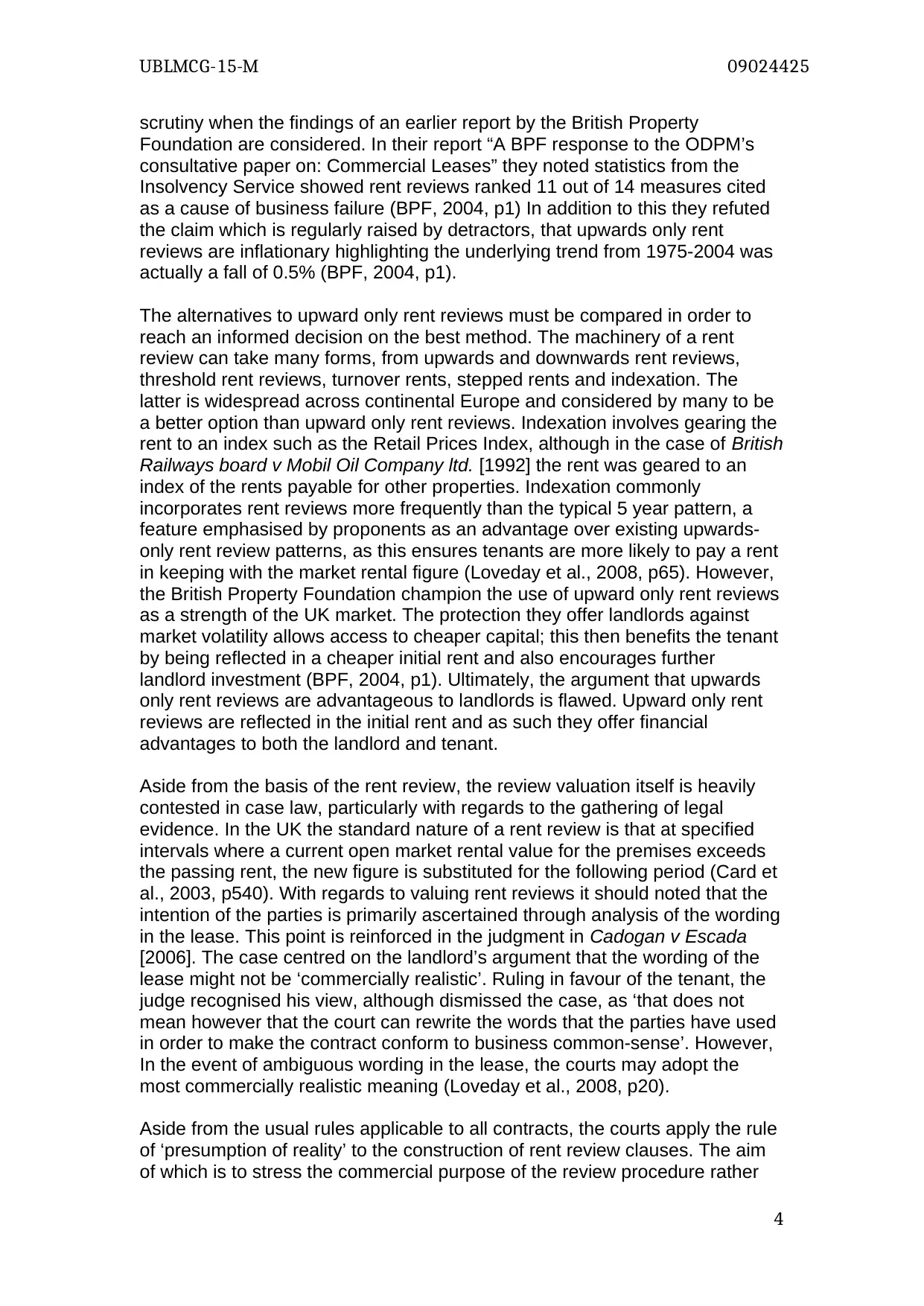
UBLMCG-15-M 09024425
scrutiny when the findings of an earlier report by the British Property
Foundation are considered. In their report “A BPF response to the ODPM’s
consultative paper on: Commercial Leases” they noted statistics from the
Insolvency Service showed rent reviews ranked 11 out of 14 measures cited
as a cause of business failure (BPF, 2004, p1) In addition to this they refuted
the claim which is regularly raised by detractors, that upwards only rent
reviews are inflationary highlighting the underlying trend from 1975-2004 was
actually a fall of 0.5% (BPF, 2004, p1).
The alternatives to upward only rent reviews must be compared in order to
reach an informed decision on the best method. The machinery of a rent
review can take many forms, from upwards and downwards rent reviews,
threshold rent reviews, turnover rents, stepped rents and indexation. The
latter is widespread across continental Europe and considered by many to be
a better option than upward only rent reviews. Indexation involves gearing the
rent to an index such as the Retail Prices Index, although in the case of British
Railways board v Mobil Oil Company ltd. [1992] the rent was geared to an
index of the rents payable for other properties. Indexation commonly
incorporates rent reviews more frequently than the typical 5 year pattern, a
feature emphasised by proponents as an advantage over existing upwards-
only rent review patterns, as this ensures tenants are more likely to pay a rent
in keeping with the market rental figure (Loveday et al., 2008, p65). However,
the British Property Foundation champion the use of upward only rent reviews
as a strength of the UK market. The protection they offer landlords against
market volatility allows access to cheaper capital; this then benefits the tenant
by being reflected in a cheaper initial rent and also encourages further
landlord investment (BPF, 2004, p1). Ultimately, the argument that upwards
only rent reviews are advantageous to landlords is flawed. Upward only rent
reviews are reflected in the initial rent and as such they offer financial
advantages to both the landlord and tenant.
Aside from the basis of the rent review, the review valuation itself is heavily
contested in case law, particularly with regards to the gathering of legal
evidence. In the UK the standard nature of a rent review is that at specified
intervals where a current open market rental value for the premises exceeds
the passing rent, the new figure is substituted for the following period (Card et
al., 2003, p540). With regards to valuing rent reviews it should noted that the
intention of the parties is primarily ascertained through analysis of the wording
in the lease. This point is reinforced in the judgment in Cadogan v Escada
[2006]. The case centred on the landlord’s argument that the wording of the
lease might not be ‘commercially realistic’. Ruling in favour of the tenant, the
judge recognised his view, although dismissed the case, as ‘that does not
mean however that the court can rewrite the words that the parties have used
in order to make the contract conform to business common-sense’. However,
In the event of ambiguous wording in the lease, the courts may adopt the
most commercially realistic meaning (Loveday et al., 2008, p20).
Aside from the usual rules applicable to all contracts, the courts apply the rule
of ‘presumption of reality’ to the construction of rent review clauses. The aim
of which is to stress the commercial purpose of the review procedure rather
4
scrutiny when the findings of an earlier report by the British Property
Foundation are considered. In their report “A BPF response to the ODPM’s
consultative paper on: Commercial Leases” they noted statistics from the
Insolvency Service showed rent reviews ranked 11 out of 14 measures cited
as a cause of business failure (BPF, 2004, p1) In addition to this they refuted
the claim which is regularly raised by detractors, that upwards only rent
reviews are inflationary highlighting the underlying trend from 1975-2004 was
actually a fall of 0.5% (BPF, 2004, p1).
The alternatives to upward only rent reviews must be compared in order to
reach an informed decision on the best method. The machinery of a rent
review can take many forms, from upwards and downwards rent reviews,
threshold rent reviews, turnover rents, stepped rents and indexation. The
latter is widespread across continental Europe and considered by many to be
a better option than upward only rent reviews. Indexation involves gearing the
rent to an index such as the Retail Prices Index, although in the case of British
Railways board v Mobil Oil Company ltd. [1992] the rent was geared to an
index of the rents payable for other properties. Indexation commonly
incorporates rent reviews more frequently than the typical 5 year pattern, a
feature emphasised by proponents as an advantage over existing upwards-
only rent review patterns, as this ensures tenants are more likely to pay a rent
in keeping with the market rental figure (Loveday et al., 2008, p65). However,
the British Property Foundation champion the use of upward only rent reviews
as a strength of the UK market. The protection they offer landlords against
market volatility allows access to cheaper capital; this then benefits the tenant
by being reflected in a cheaper initial rent and also encourages further
landlord investment (BPF, 2004, p1). Ultimately, the argument that upwards
only rent reviews are advantageous to landlords is flawed. Upward only rent
reviews are reflected in the initial rent and as such they offer financial
advantages to both the landlord and tenant.
Aside from the basis of the rent review, the review valuation itself is heavily
contested in case law, particularly with regards to the gathering of legal
evidence. In the UK the standard nature of a rent review is that at specified
intervals where a current open market rental value for the premises exceeds
the passing rent, the new figure is substituted for the following period (Card et
al., 2003, p540). With regards to valuing rent reviews it should noted that the
intention of the parties is primarily ascertained through analysis of the wording
in the lease. This point is reinforced in the judgment in Cadogan v Escada
[2006]. The case centred on the landlord’s argument that the wording of the
lease might not be ‘commercially realistic’. Ruling in favour of the tenant, the
judge recognised his view, although dismissed the case, as ‘that does not
mean however that the court can rewrite the words that the parties have used
in order to make the contract conform to business common-sense’. However,
In the event of ambiguous wording in the lease, the courts may adopt the
most commercially realistic meaning (Loveday et al., 2008, p20).
Aside from the usual rules applicable to all contracts, the courts apply the rule
of ‘presumption of reality’ to the construction of rent review clauses. The aim
of which is to stress the commercial purpose of the review procedure rather
4
Paraphrase This Document
Need a fresh take? Get an instant paraphrase of this document with our AI Paraphraser
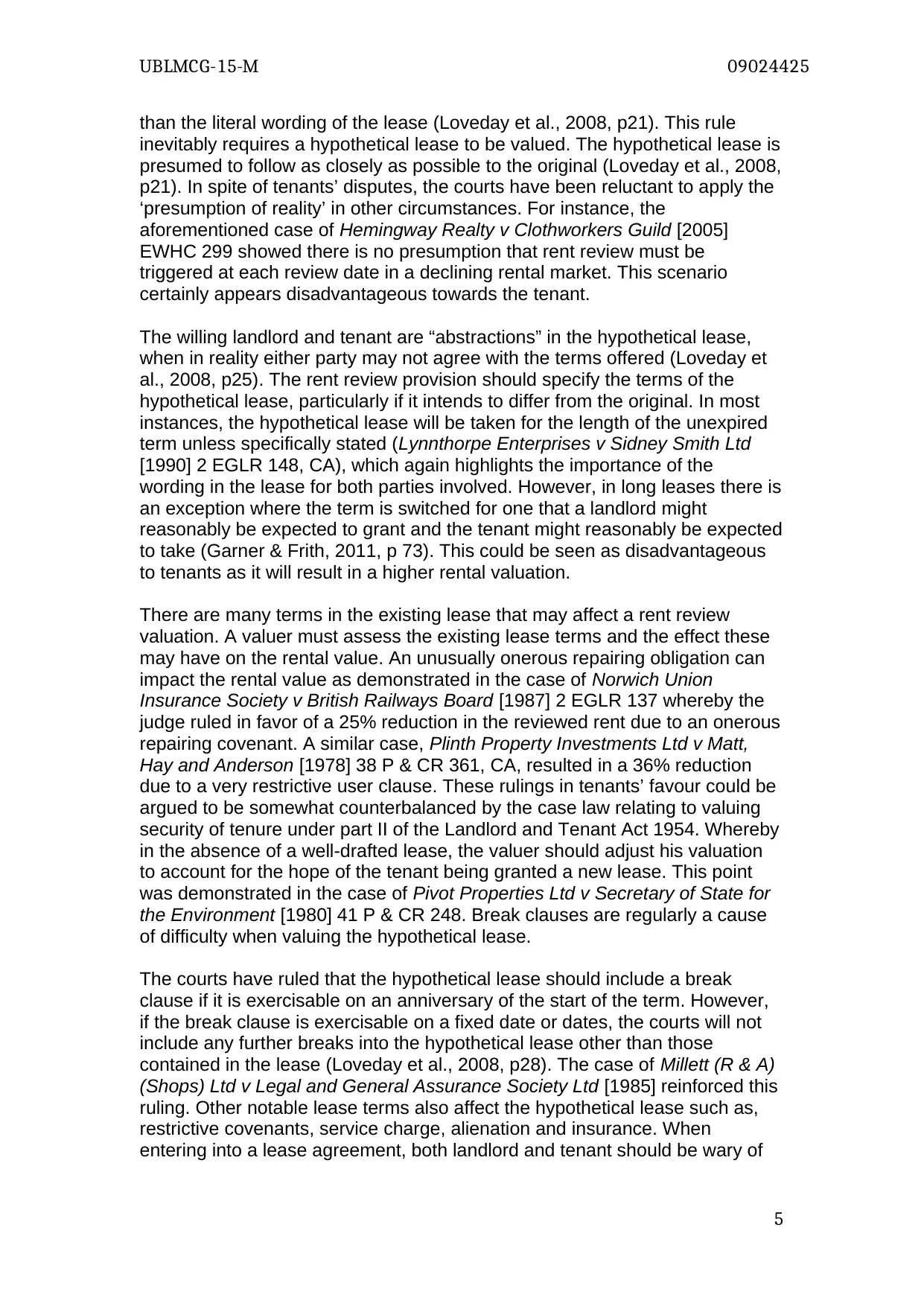
UBLMCG-15-M 09024425
than the literal wording of the lease (Loveday et al., 2008, p21). This rule
inevitably requires a hypothetical lease to be valued. The hypothetical lease is
presumed to follow as closely as possible to the original (Loveday et al., 2008,
p21). In spite of tenants’ disputes, the courts have been reluctant to apply the
‘presumption of reality’ in other circumstances. For instance, the
aforementioned case of Hemingway Realty v Clothworkers Guild [2005]
EWHC 299 showed there is no presumption that rent review must be
triggered at each review date in a declining rental market. This scenario
certainly appears disadvantageous towards the tenant.
The willing landlord and tenant are “abstractions” in the hypothetical lease,
when in reality either party may not agree with the terms offered (Loveday et
al., 2008, p25). The rent review provision should specify the terms of the
hypothetical lease, particularly if it intends to differ from the original. In most
instances, the hypothetical lease will be taken for the length of the unexpired
term unless specifically stated (Lynnthorpe Enterprises v Sidney Smith Ltd
[1990] 2 EGLR 148, CA), which again highlights the importance of the
wording in the lease for both parties involved. However, in long leases there is
an exception where the term is switched for one that a landlord might
reasonably be expected to grant and the tenant might reasonably be expected
to take (Garner & Frith, 2011, p 73). This could be seen as disadvantageous
to tenants as it will result in a higher rental valuation.
There are many terms in the existing lease that may affect a rent review
valuation. A valuer must assess the existing lease terms and the effect these
may have on the rental value. An unusually onerous repairing obligation can
impact the rental value as demonstrated in the case of Norwich Union
Insurance Society v British Railways Board [1987] 2 EGLR 137 whereby the
judge ruled in favor of a 25% reduction in the reviewed rent due to an onerous
repairing covenant. A similar case, Plinth Property Investments Ltd v Matt,
Hay and Anderson [1978] 38 P & CR 361, CA, resulted in a 36% reduction
due to a very restrictive user clause. These rulings in tenants’ favour could be
argued to be somewhat counterbalanced by the case law relating to valuing
security of tenure under part II of the Landlord and Tenant Act 1954. Whereby
in the absence of a well-drafted lease, the valuer should adjust his valuation
to account for the hope of the tenant being granted a new lease. This point
was demonstrated in the case of Pivot Properties Ltd v Secretary of State for
the Environment [1980] 41 P & CR 248. Break clauses are regularly a cause
of difficulty when valuing the hypothetical lease.
The courts have ruled that the hypothetical lease should include a break
clause if it is exercisable on an anniversary of the start of the term. However,
if the break clause is exercisable on a fixed date or dates, the courts will not
include any further breaks into the hypothetical lease other than those
contained in the lease (Loveday et al., 2008, p28). The case of Millett (R & A)
(Shops) Ltd v Legal and General Assurance Society Ltd [1985] reinforced this
ruling. Other notable lease terms also affect the hypothetical lease such as,
restrictive covenants, service charge, alienation and insurance. When
entering into a lease agreement, both landlord and tenant should be wary of
5
than the literal wording of the lease (Loveday et al., 2008, p21). This rule
inevitably requires a hypothetical lease to be valued. The hypothetical lease is
presumed to follow as closely as possible to the original (Loveday et al., 2008,
p21). In spite of tenants’ disputes, the courts have been reluctant to apply the
‘presumption of reality’ in other circumstances. For instance, the
aforementioned case of Hemingway Realty v Clothworkers Guild [2005]
EWHC 299 showed there is no presumption that rent review must be
triggered at each review date in a declining rental market. This scenario
certainly appears disadvantageous towards the tenant.
The willing landlord and tenant are “abstractions” in the hypothetical lease,
when in reality either party may not agree with the terms offered (Loveday et
al., 2008, p25). The rent review provision should specify the terms of the
hypothetical lease, particularly if it intends to differ from the original. In most
instances, the hypothetical lease will be taken for the length of the unexpired
term unless specifically stated (Lynnthorpe Enterprises v Sidney Smith Ltd
[1990] 2 EGLR 148, CA), which again highlights the importance of the
wording in the lease for both parties involved. However, in long leases there is
an exception where the term is switched for one that a landlord might
reasonably be expected to grant and the tenant might reasonably be expected
to take (Garner & Frith, 2011, p 73). This could be seen as disadvantageous
to tenants as it will result in a higher rental valuation.
There are many terms in the existing lease that may affect a rent review
valuation. A valuer must assess the existing lease terms and the effect these
may have on the rental value. An unusually onerous repairing obligation can
impact the rental value as demonstrated in the case of Norwich Union
Insurance Society v British Railways Board [1987] 2 EGLR 137 whereby the
judge ruled in favor of a 25% reduction in the reviewed rent due to an onerous
repairing covenant. A similar case, Plinth Property Investments Ltd v Matt,
Hay and Anderson [1978] 38 P & CR 361, CA, resulted in a 36% reduction
due to a very restrictive user clause. These rulings in tenants’ favour could be
argued to be somewhat counterbalanced by the case law relating to valuing
security of tenure under part II of the Landlord and Tenant Act 1954. Whereby
in the absence of a well-drafted lease, the valuer should adjust his valuation
to account for the hope of the tenant being granted a new lease. This point
was demonstrated in the case of Pivot Properties Ltd v Secretary of State for
the Environment [1980] 41 P & CR 248. Break clauses are regularly a cause
of difficulty when valuing the hypothetical lease.
The courts have ruled that the hypothetical lease should include a break
clause if it is exercisable on an anniversary of the start of the term. However,
if the break clause is exercisable on a fixed date or dates, the courts will not
include any further breaks into the hypothetical lease other than those
contained in the lease (Loveday et al., 2008, p28). The case of Millett (R & A)
(Shops) Ltd v Legal and General Assurance Society Ltd [1985] reinforced this
ruling. Other notable lease terms also affect the hypothetical lease such as,
restrictive covenants, service charge, alienation and insurance. When
entering into a lease agreement, both landlord and tenant should be wary of
5
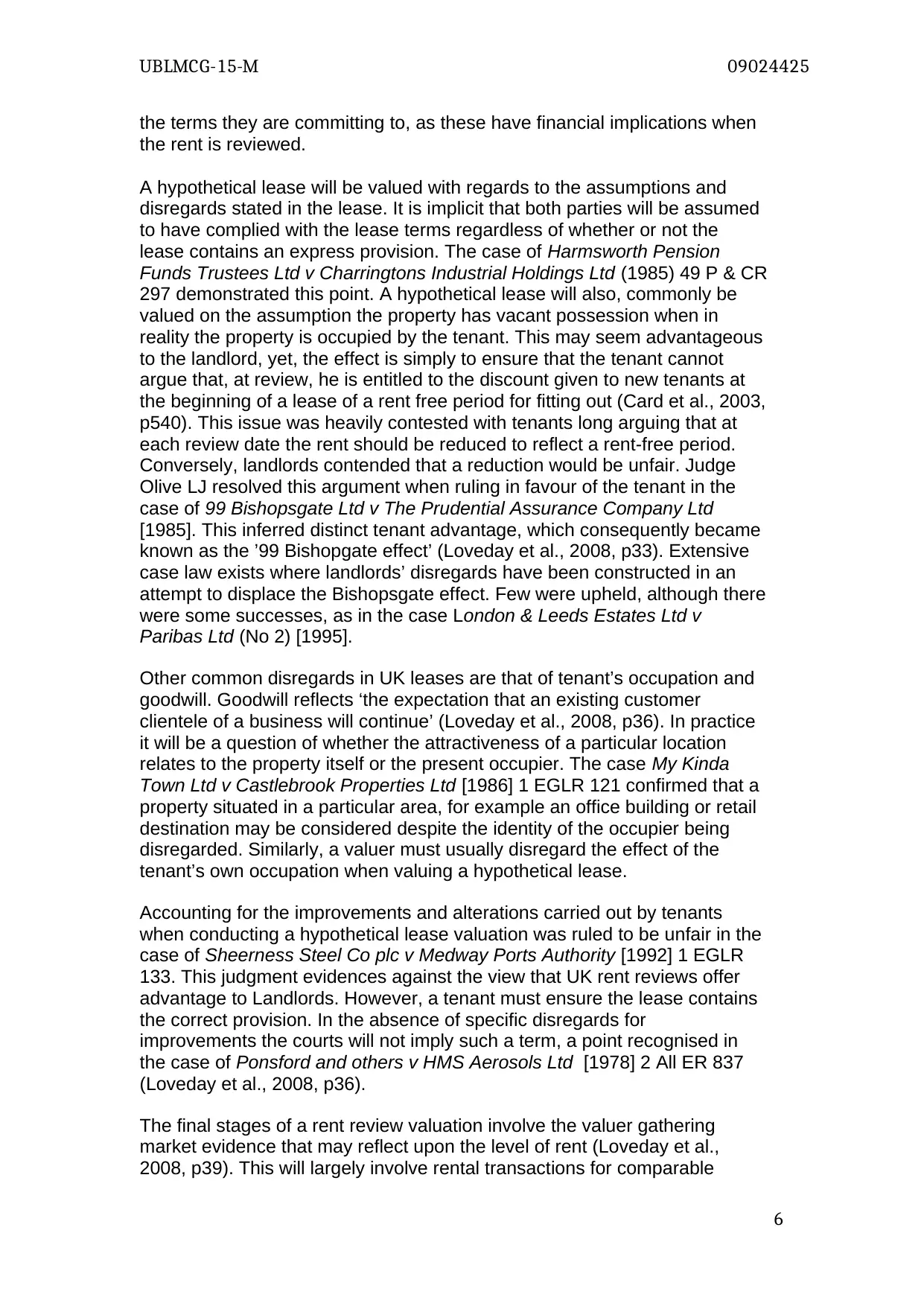
UBLMCG-15-M 09024425
the terms they are committing to, as these have financial implications when
the rent is reviewed.
A hypothetical lease will be valued with regards to the assumptions and
disregards stated in the lease. It is implicit that both parties will be assumed
to have complied with the lease terms regardless of whether or not the
lease contains an express provision. The case of Harmsworth Pension
Funds Trustees Ltd v Charringtons Industrial Holdings Ltd (1985) 49 P & CR
297 demonstrated this point. A hypothetical lease will also, commonly be
valued on the assumption the property has vacant possession when in
reality the property is occupied by the tenant. This may seem advantageous
to the landlord, yet, the effect is simply to ensure that the tenant cannot
argue that, at review, he is entitled to the discount given to new tenants at
the beginning of a lease of a rent free period for fitting out (Card et al., 2003,
p540). This issue was heavily contested with tenants long arguing that at
each review date the rent should be reduced to reflect a rent-free period.
Conversely, landlords contended that a reduction would be unfair. Judge
Olive LJ resolved this argument when ruling in favour of the tenant in the
case of 99 Bishopsgate Ltd v The Prudential Assurance Company Ltd
[1985]. This inferred distinct tenant advantage, which consequently became
known as the ’99 Bishopgate effect’ (Loveday et al., 2008, p33). Extensive
case law exists where landlords’ disregards have been constructed in an
attempt to displace the Bishopsgate effect. Few were upheld, although there
were some successes, as in the case London & Leeds Estates Ltd v
Paribas Ltd (No 2) [1995].
Other common disregards in UK leases are that of tenant’s occupation and
goodwill. Goodwill reflects ‘the expectation that an existing customer
clientele of a business will continue’ (Loveday et al., 2008, p36). In practice
it will be a question of whether the attractiveness of a particular location
relates to the property itself or the present occupier. The case My Kinda
Town Ltd v Castlebrook Properties Ltd [1986] 1 EGLR 121 confirmed that a
property situated in a particular area, for example an office building or retail
destination may be considered despite the identity of the occupier being
disregarded. Similarly, a valuer must usually disregard the effect of the
tenant’s own occupation when valuing a hypothetical lease.
Accounting for the improvements and alterations carried out by tenants
when conducting a hypothetical lease valuation was ruled to be unfair in the
case of Sheerness Steel Co plc v Medway Ports Authority [1992] 1 EGLR
133. This judgment evidences against the view that UK rent reviews offer
advantage to Landlords. However, a tenant must ensure the lease contains
the correct provision. In the absence of specific disregards for
improvements the courts will not imply such a term, a point recognised in
the case of Ponsford and others v HMS Aerosols Ltd [1978] 2 All ER 837
(Loveday et al., 2008, p36).
The final stages of a rent review valuation involve the valuer gathering
market evidence that may reflect upon the level of rent (Loveday et al.,
2008, p39). This will largely involve rental transactions for comparable
6
the terms they are committing to, as these have financial implications when
the rent is reviewed.
A hypothetical lease will be valued with regards to the assumptions and
disregards stated in the lease. It is implicit that both parties will be assumed
to have complied with the lease terms regardless of whether or not the
lease contains an express provision. The case of Harmsworth Pension
Funds Trustees Ltd v Charringtons Industrial Holdings Ltd (1985) 49 P & CR
297 demonstrated this point. A hypothetical lease will also, commonly be
valued on the assumption the property has vacant possession when in
reality the property is occupied by the tenant. This may seem advantageous
to the landlord, yet, the effect is simply to ensure that the tenant cannot
argue that, at review, he is entitled to the discount given to new tenants at
the beginning of a lease of a rent free period for fitting out (Card et al., 2003,
p540). This issue was heavily contested with tenants long arguing that at
each review date the rent should be reduced to reflect a rent-free period.
Conversely, landlords contended that a reduction would be unfair. Judge
Olive LJ resolved this argument when ruling in favour of the tenant in the
case of 99 Bishopsgate Ltd v The Prudential Assurance Company Ltd
[1985]. This inferred distinct tenant advantage, which consequently became
known as the ’99 Bishopgate effect’ (Loveday et al., 2008, p33). Extensive
case law exists where landlords’ disregards have been constructed in an
attempt to displace the Bishopsgate effect. Few were upheld, although there
were some successes, as in the case London & Leeds Estates Ltd v
Paribas Ltd (No 2) [1995].
Other common disregards in UK leases are that of tenant’s occupation and
goodwill. Goodwill reflects ‘the expectation that an existing customer
clientele of a business will continue’ (Loveday et al., 2008, p36). In practice
it will be a question of whether the attractiveness of a particular location
relates to the property itself or the present occupier. The case My Kinda
Town Ltd v Castlebrook Properties Ltd [1986] 1 EGLR 121 confirmed that a
property situated in a particular area, for example an office building or retail
destination may be considered despite the identity of the occupier being
disregarded. Similarly, a valuer must usually disregard the effect of the
tenant’s own occupation when valuing a hypothetical lease.
Accounting for the improvements and alterations carried out by tenants
when conducting a hypothetical lease valuation was ruled to be unfair in the
case of Sheerness Steel Co plc v Medway Ports Authority [1992] 1 EGLR
133. This judgment evidences against the view that UK rent reviews offer
advantage to Landlords. However, a tenant must ensure the lease contains
the correct provision. In the absence of specific disregards for
improvements the courts will not imply such a term, a point recognised in
the case of Ponsford and others v HMS Aerosols Ltd [1978] 2 All ER 837
(Loveday et al., 2008, p36).
The final stages of a rent review valuation involve the valuer gathering
market evidence that may reflect upon the level of rent (Loveday et al.,
2008, p39). This will largely involve rental transactions for comparable
6
⊘ This is a preview!⊘
Do you want full access?
Subscribe today to unlock all pages.

Trusted by 1+ million students worldwide
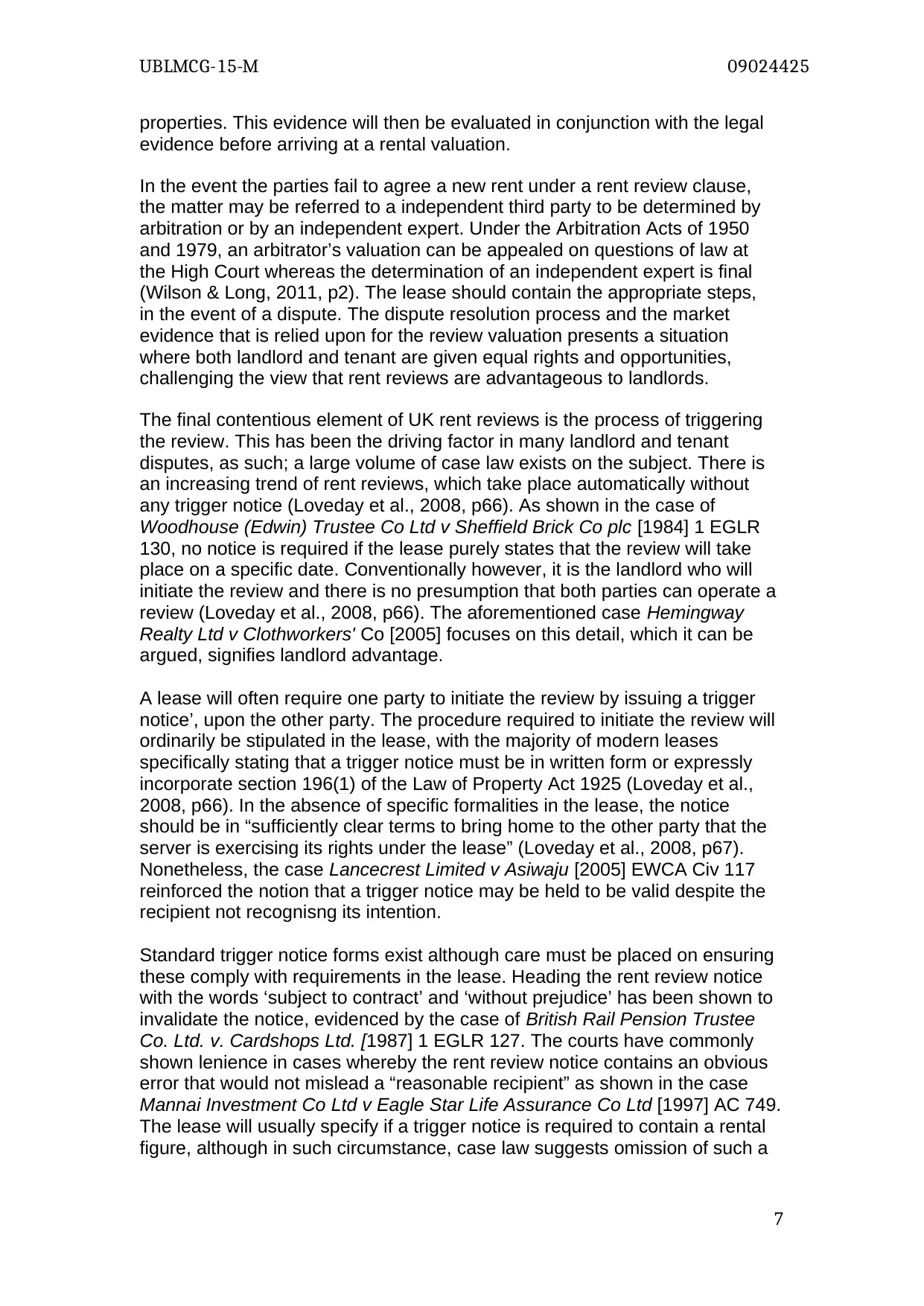
UBLMCG-15-M 09024425
properties. This evidence will then be evaluated in conjunction with the legal
evidence before arriving at a rental valuation.
In the event the parties fail to agree a new rent under a rent review clause,
the matter may be referred to a independent third party to be determined by
arbitration or by an independent expert. Under the Arbitration Acts of 1950
and 1979, an arbitrator’s valuation can be appealed on questions of law at
the High Court whereas the determination of an independent expert is final
(Wilson & Long, 2011, p2). The lease should contain the appropriate steps,
in the event of a dispute. The dispute resolution process and the market
evidence that is relied upon for the review valuation presents a situation
where both landlord and tenant are given equal rights and opportunities,
challenging the view that rent reviews are advantageous to landlords.
The final contentious element of UK rent reviews is the process of triggering
the review. This has been the driving factor in many landlord and tenant
disputes, as such; a large volume of case law exists on the subject. There is
an increasing trend of rent reviews, which take place automatically without
any trigger notice (Loveday et al., 2008, p66). As shown in the case of
Woodhouse (Edwin) Trustee Co Ltd v Sheffield Brick Co plc [1984] 1 EGLR
130, no notice is required if the lease purely states that the review will take
place on a specific date. Conventionally however, it is the landlord who will
initiate the review and there is no presumption that both parties can operate a
review (Loveday et al., 2008, p66). The aforementioned case Hemingway
Realty Ltd v Clothworkers' Co [2005] focuses on this detail, which it can be
argued, signifies landlord advantage.
A lease will often require one party to initiate the review by issuing a trigger
notice’, upon the other party. The procedure required to initiate the review will
ordinarily be stipulated in the lease, with the majority of modern leases
specifically stating that a trigger notice must be in written form or expressly
incorporate section 196(1) of the Law of Property Act 1925 (Loveday et al.,
2008, p66). In the absence of specific formalities in the lease, the notice
should be in “sufficiently clear terms to bring home to the other party that the
server is exercising its rights under the lease” (Loveday et al., 2008, p67).
Nonetheless, the case Lancecrest Limited v Asiwaju [2005] EWCA Civ 117
reinforced the notion that a trigger notice may be held to be valid despite the
recipient not recognisng its intention.
Standard trigger notice forms exist although care must be placed on ensuring
these comply with requirements in the lease. Heading the rent review notice
with the words ‘subject to contract’ and ‘without prejudice’ has been shown to
invalidate the notice, evidenced by the case of British Rail Pension Trustee
Co. Ltd. v. Cardshops Ltd. [1987] 1 EGLR 127. The courts have commonly
shown lenience in cases whereby the rent review notice contains an obvious
error that would not mislead a “reasonable recipient” as shown in the case
Mannai Investment Co Ltd v Eagle Star Life Assurance Co Ltd [1997] AC 749.
The lease will usually specify if a trigger notice is required to contain a rental
figure, although in such circumstance, case law suggests omission of such a
7
properties. This evidence will then be evaluated in conjunction with the legal
evidence before arriving at a rental valuation.
In the event the parties fail to agree a new rent under a rent review clause,
the matter may be referred to a independent third party to be determined by
arbitration or by an independent expert. Under the Arbitration Acts of 1950
and 1979, an arbitrator’s valuation can be appealed on questions of law at
the High Court whereas the determination of an independent expert is final
(Wilson & Long, 2011, p2). The lease should contain the appropriate steps,
in the event of a dispute. The dispute resolution process and the market
evidence that is relied upon for the review valuation presents a situation
where both landlord and tenant are given equal rights and opportunities,
challenging the view that rent reviews are advantageous to landlords.
The final contentious element of UK rent reviews is the process of triggering
the review. This has been the driving factor in many landlord and tenant
disputes, as such; a large volume of case law exists on the subject. There is
an increasing trend of rent reviews, which take place automatically without
any trigger notice (Loveday et al., 2008, p66). As shown in the case of
Woodhouse (Edwin) Trustee Co Ltd v Sheffield Brick Co plc [1984] 1 EGLR
130, no notice is required if the lease purely states that the review will take
place on a specific date. Conventionally however, it is the landlord who will
initiate the review and there is no presumption that both parties can operate a
review (Loveday et al., 2008, p66). The aforementioned case Hemingway
Realty Ltd v Clothworkers' Co [2005] focuses on this detail, which it can be
argued, signifies landlord advantage.
A lease will often require one party to initiate the review by issuing a trigger
notice’, upon the other party. The procedure required to initiate the review will
ordinarily be stipulated in the lease, with the majority of modern leases
specifically stating that a trigger notice must be in written form or expressly
incorporate section 196(1) of the Law of Property Act 1925 (Loveday et al.,
2008, p66). In the absence of specific formalities in the lease, the notice
should be in “sufficiently clear terms to bring home to the other party that the
server is exercising its rights under the lease” (Loveday et al., 2008, p67).
Nonetheless, the case Lancecrest Limited v Asiwaju [2005] EWCA Civ 117
reinforced the notion that a trigger notice may be held to be valid despite the
recipient not recognisng its intention.
Standard trigger notice forms exist although care must be placed on ensuring
these comply with requirements in the lease. Heading the rent review notice
with the words ‘subject to contract’ and ‘without prejudice’ has been shown to
invalidate the notice, evidenced by the case of British Rail Pension Trustee
Co. Ltd. v. Cardshops Ltd. [1987] 1 EGLR 127. The courts have commonly
shown lenience in cases whereby the rent review notice contains an obvious
error that would not mislead a “reasonable recipient” as shown in the case
Mannai Investment Co Ltd v Eagle Star Life Assurance Co Ltd [1997] AC 749.
The lease will usually specify if a trigger notice is required to contain a rental
figure, although in such circumstance, case law suggests omission of such a
7
Paraphrase This Document
Need a fresh take? Get an instant paraphrase of this document with our AI Paraphraser
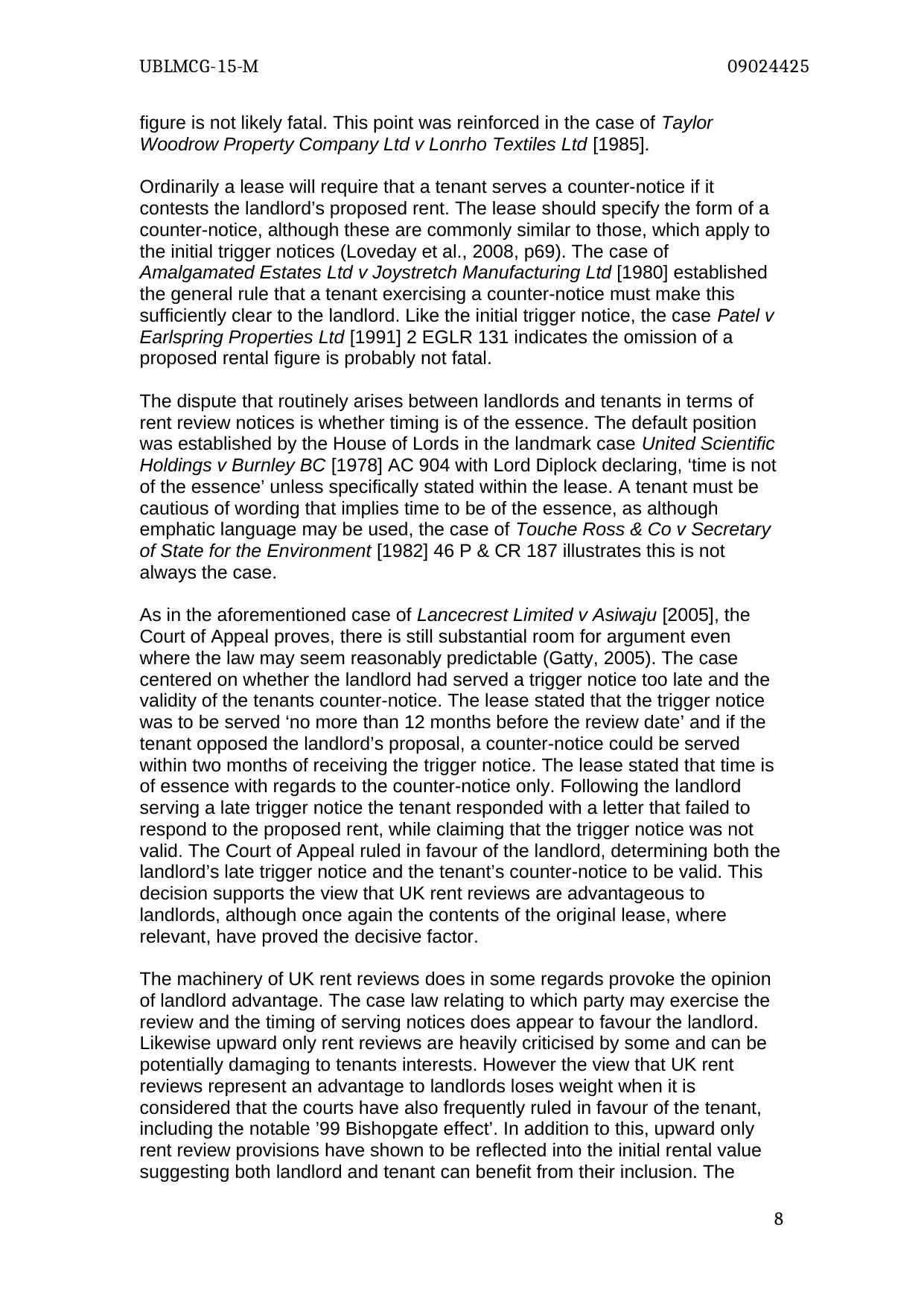
UBLMCG-15-M 09024425
figure is not likely fatal. This point was reinforced in the case of Taylor
Woodrow Property Company Ltd v Lonrho Textiles Ltd [1985].
Ordinarily a lease will require that a tenant serves a counter-notice if it
contests the landlord’s proposed rent. The lease should specify the form of a
counter-notice, although these are commonly similar to those, which apply to
the initial trigger notices (Loveday et al., 2008, p69). The case of
Amalgamated Estates Ltd v Joystretch Manufacturing Ltd [1980] established
the general rule that a tenant exercising a counter-notice must make this
sufficiently clear to the landlord. Like the initial trigger notice, the case Patel v
Earlspring Properties Ltd [1991] 2 EGLR 131 indicates the omission of a
proposed rental figure is probably not fatal.
The dispute that routinely arises between landlords and tenants in terms of
rent review notices is whether timing is of the essence. The default position
was established by the House of Lords in the landmark case United Scientific
Holdings v Burnley BC [1978] AC 904 with Lord Diplock declaring, ‘time is not
of the essence’ unless specifically stated within the lease. A tenant must be
cautious of wording that implies time to be of the essence, as although
emphatic language may be used, the case of Touche Ross & Co v Secretary
of State for the Environment [1982] 46 P & CR 187 illustrates this is not
always the case.
As in the aforementioned case of Lancecrest Limited v Asiwaju [2005], the
Court of Appeal proves, there is still substantial room for argument even
where the law may seem reasonably predictable (Gatty, 2005). The case
centered on whether the landlord had served a trigger notice too late and the
validity of the tenants counter-notice. The lease stated that the trigger notice
was to be served ‘no more than 12 months before the review date’ and if the
tenant opposed the landlord’s proposal, a counter-notice could be served
within two months of receiving the trigger notice. The lease stated that time is
of essence with regards to the counter-notice only. Following the landlord
serving a late trigger notice the tenant responded with a letter that failed to
respond to the proposed rent, while claiming that the trigger notice was not
valid. The Court of Appeal ruled in favour of the landlord, determining both the
landlord’s late trigger notice and the tenant’s counter-notice to be valid. This
decision supports the view that UK rent reviews are advantageous to
landlords, although once again the contents of the original lease, where
relevant, have proved the decisive factor.
The machinery of UK rent reviews does in some regards provoke the opinion
of landlord advantage. The case law relating to which party may exercise the
review and the timing of serving notices does appear to favour the landlord.
Likewise upward only rent reviews are heavily criticised by some and can be
potentially damaging to tenants interests. However the view that UK rent
reviews represent an advantage to landlords loses weight when it is
considered that the courts have also frequently ruled in favour of the tenant,
including the notable ’99 Bishopgate effect’. In addition to this, upward only
rent review provisions have shown to be reflected into the initial rental value
suggesting both landlord and tenant can benefit from their inclusion. The
8
figure is not likely fatal. This point was reinforced in the case of Taylor
Woodrow Property Company Ltd v Lonrho Textiles Ltd [1985].
Ordinarily a lease will require that a tenant serves a counter-notice if it
contests the landlord’s proposed rent. The lease should specify the form of a
counter-notice, although these are commonly similar to those, which apply to
the initial trigger notices (Loveday et al., 2008, p69). The case of
Amalgamated Estates Ltd v Joystretch Manufacturing Ltd [1980] established
the general rule that a tenant exercising a counter-notice must make this
sufficiently clear to the landlord. Like the initial trigger notice, the case Patel v
Earlspring Properties Ltd [1991] 2 EGLR 131 indicates the omission of a
proposed rental figure is probably not fatal.
The dispute that routinely arises between landlords and tenants in terms of
rent review notices is whether timing is of the essence. The default position
was established by the House of Lords in the landmark case United Scientific
Holdings v Burnley BC [1978] AC 904 with Lord Diplock declaring, ‘time is not
of the essence’ unless specifically stated within the lease. A tenant must be
cautious of wording that implies time to be of the essence, as although
emphatic language may be used, the case of Touche Ross & Co v Secretary
of State for the Environment [1982] 46 P & CR 187 illustrates this is not
always the case.
As in the aforementioned case of Lancecrest Limited v Asiwaju [2005], the
Court of Appeal proves, there is still substantial room for argument even
where the law may seem reasonably predictable (Gatty, 2005). The case
centered on whether the landlord had served a trigger notice too late and the
validity of the tenants counter-notice. The lease stated that the trigger notice
was to be served ‘no more than 12 months before the review date’ and if the
tenant opposed the landlord’s proposal, a counter-notice could be served
within two months of receiving the trigger notice. The lease stated that time is
of essence with regards to the counter-notice only. Following the landlord
serving a late trigger notice the tenant responded with a letter that failed to
respond to the proposed rent, while claiming that the trigger notice was not
valid. The Court of Appeal ruled in favour of the landlord, determining both the
landlord’s late trigger notice and the tenant’s counter-notice to be valid. This
decision supports the view that UK rent reviews are advantageous to
landlords, although once again the contents of the original lease, where
relevant, have proved the decisive factor.
The machinery of UK rent reviews does in some regards provoke the opinion
of landlord advantage. The case law relating to which party may exercise the
review and the timing of serving notices does appear to favour the landlord.
Likewise upward only rent reviews are heavily criticised by some and can be
potentially damaging to tenants interests. However the view that UK rent
reviews represent an advantage to landlords loses weight when it is
considered that the courts have also frequently ruled in favour of the tenant,
including the notable ’99 Bishopgate effect’. In addition to this, upward only
rent review provisions have shown to be reflected into the initial rental value
suggesting both landlord and tenant can benefit from their inclusion. The
8

UBLMCG-15-M 09024425
biggest issue with UK rent reviews appears to be the lack of understanding by
small business owners in relation to lease terms. This prompted the
Government to develop the codes of practice previously mentioned, in an
attempt to raise awareness. On reflection, UK rent reviews seem fairly
balanced and the perception of landlord advantage is short-sighted. In the
majority of cases, the wording of the lease agreement has proved crucial in
court judgment and failure to recognise the effect of certain wording by either
party may have detrimental outcomes on review.
9
biggest issue with UK rent reviews appears to be the lack of understanding by
small business owners in relation to lease terms. This prompted the
Government to develop the codes of practice previously mentioned, in an
attempt to raise awareness. On reflection, UK rent reviews seem fairly
balanced and the perception of landlord advantage is short-sighted. In the
majority of cases, the wording of the lease agreement has proved crucial in
court judgment and failure to recognise the effect of certain wording by either
party may have detrimental outcomes on review.
9
⊘ This is a preview!⊘
Do you want full access?
Subscribe today to unlock all pages.

Trusted by 1+ million students worldwide
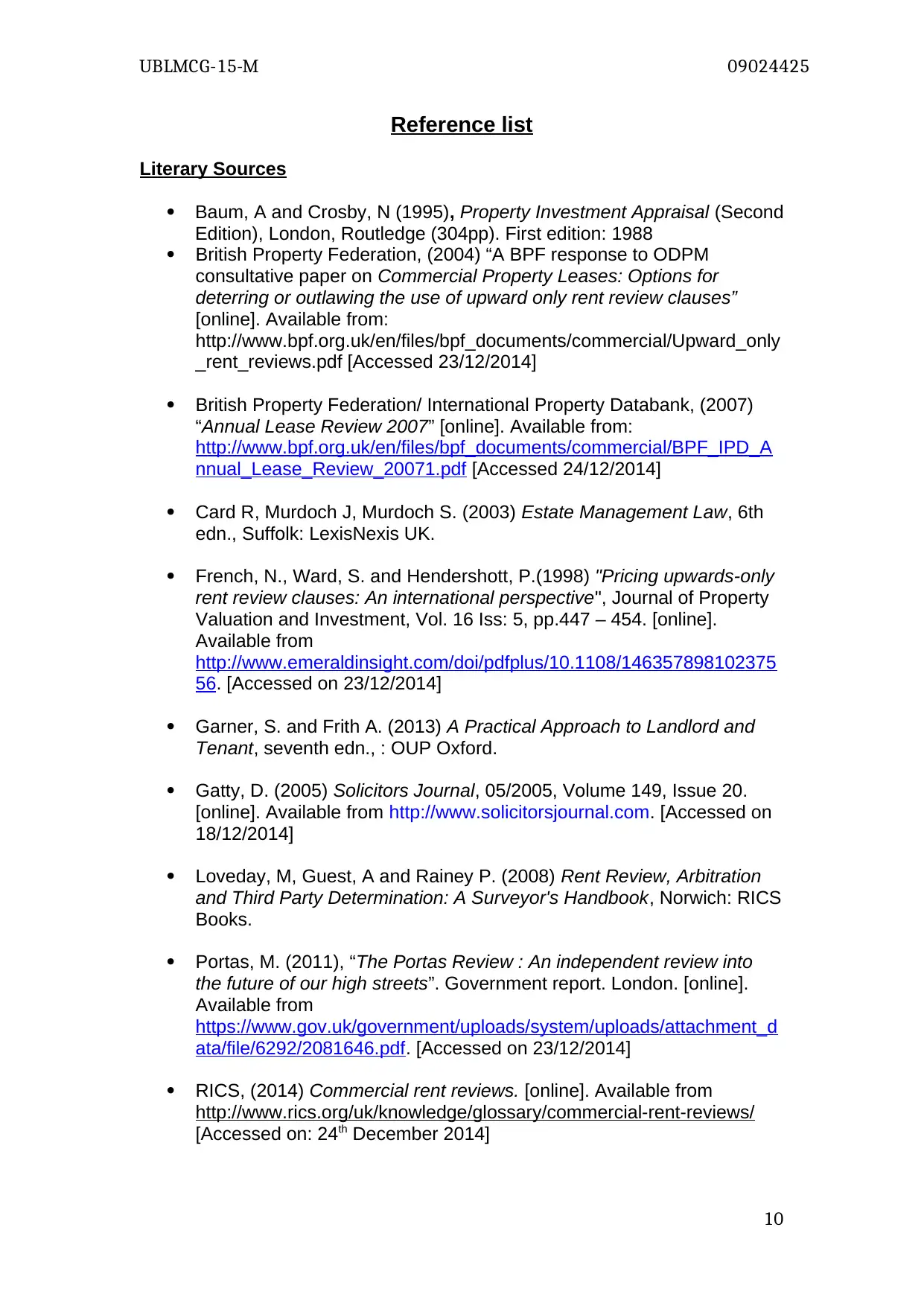
UBLMCG-15-M 09024425
Reference list
Literary Sources
Baum, A and Crosby, N (1995), Property Investment Appraisal (Second
Edition), London, Routledge (304pp). First edition: 1988
British Property Federation, (2004) “A BPF response to ODPM
consultative paper on Commercial Property Leases: Options for
deterring or outlawing the use of upward only rent review clauses”
[online]. Available from:
http://www.bpf.org.uk/en/files/bpf_documents/commercial/Upward_only
_rent_reviews.pdf [Accessed 23/12/2014]
British Property Federation/ International Property Databank, (2007)
“Annual Lease Review 2007” [online]. Available from:
http://www.bpf.org.uk/en/files/bpf_documents/commercial/BPF_IPD_A
nnual_Lease_Review_20071.pdf [Accessed 24/12/2014]
Card R, Murdoch J, Murdoch S. (2003) Estate Management Law, 6th
edn., Suffolk: LexisNexis UK.
French, N., Ward, S. and Hendershott, P.(1998) "Pricing upwards‐only
rent review clauses: An international perspective", Journal of Property
Valuation and Investment, Vol. 16 Iss: 5, pp.447 – 454. [online].
Available from
http://www.emeraldinsight.com/doi/pdfplus/10.1108/146357898102375
56. [Accessed on 23/12/2014]
Garner, S. and Frith A. (2013) A Practical Approach to Landlord and
Tenant, seventh edn., : OUP Oxford.
Gatty, D. (2005) Solicitors Journal, 05/2005, Volume 149, Issue 20.
[online]. Available from http://www.solicitorsjournal.com. [Accessed on
18/12/2014]
Loveday, M, Guest, A and Rainey P. (2008) Rent Review, Arbitration
and Third Party Determination: A Surveyor's Handbook, Norwich: RICS
Books.
Portas, M. (2011), “The Portas Review : An independent review into
the future of our high streets”. Government report. London. [online].
Available from
https://www.gov.uk/government/uploads/system/uploads/attachment_d
ata/file/6292/2081646.pdf. [Accessed on 23/12/2014]
RICS, (2014) Commercial rent reviews. [online]. Available from
http://www.rics.org/uk/knowledge/glossary/commercial-rent-reviews/
[Accessed on: 24th December 2014]
10
Reference list
Literary Sources
Baum, A and Crosby, N (1995), Property Investment Appraisal (Second
Edition), London, Routledge (304pp). First edition: 1988
British Property Federation, (2004) “A BPF response to ODPM
consultative paper on Commercial Property Leases: Options for
deterring or outlawing the use of upward only rent review clauses”
[online]. Available from:
http://www.bpf.org.uk/en/files/bpf_documents/commercial/Upward_only
_rent_reviews.pdf [Accessed 23/12/2014]
British Property Federation/ International Property Databank, (2007)
“Annual Lease Review 2007” [online]. Available from:
http://www.bpf.org.uk/en/files/bpf_documents/commercial/BPF_IPD_A
nnual_Lease_Review_20071.pdf [Accessed 24/12/2014]
Card R, Murdoch J, Murdoch S. (2003) Estate Management Law, 6th
edn., Suffolk: LexisNexis UK.
French, N., Ward, S. and Hendershott, P.(1998) "Pricing upwards‐only
rent review clauses: An international perspective", Journal of Property
Valuation and Investment, Vol. 16 Iss: 5, pp.447 – 454. [online].
Available from
http://www.emeraldinsight.com/doi/pdfplus/10.1108/146357898102375
56. [Accessed on 23/12/2014]
Garner, S. and Frith A. (2013) A Practical Approach to Landlord and
Tenant, seventh edn., : OUP Oxford.
Gatty, D. (2005) Solicitors Journal, 05/2005, Volume 149, Issue 20.
[online]. Available from http://www.solicitorsjournal.com. [Accessed on
18/12/2014]
Loveday, M, Guest, A and Rainey P. (2008) Rent Review, Arbitration
and Third Party Determination: A Surveyor's Handbook, Norwich: RICS
Books.
Portas, M. (2011), “The Portas Review : An independent review into
the future of our high streets”. Government report. London. [online].
Available from
https://www.gov.uk/government/uploads/system/uploads/attachment_d
ata/file/6292/2081646.pdf. [Accessed on 23/12/2014]
RICS, (2014) Commercial rent reviews. [online]. Available from
http://www.rics.org/uk/knowledge/glossary/commercial-rent-reviews/
[Accessed on: 24th December 2014]
10
Paraphrase This Document
Need a fresh take? Get an instant paraphrase of this document with our AI Paraphraser
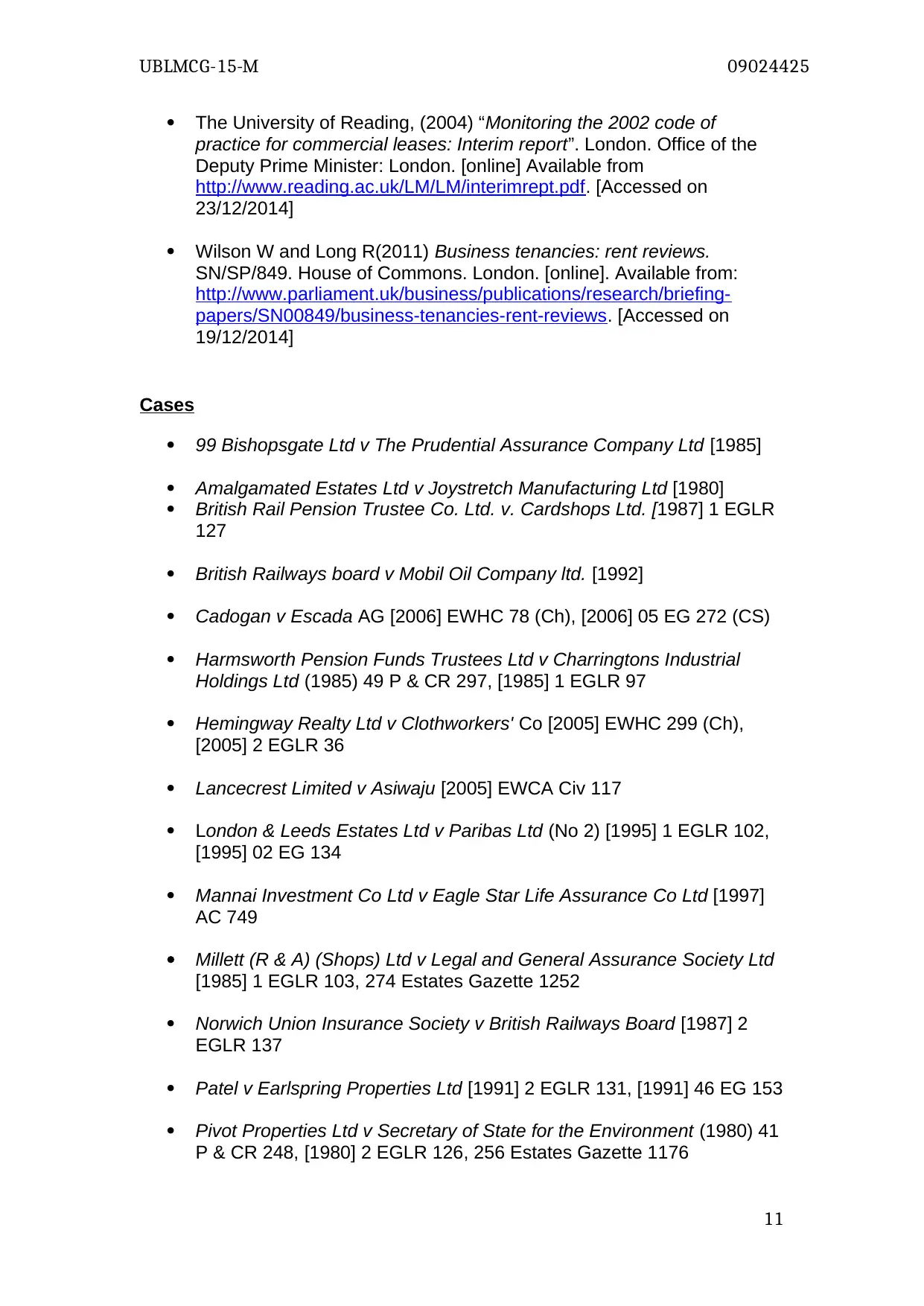
UBLMCG-15-M 09024425
The University of Reading, (2004) “Monitoring the 2002 code of
practice for commercial leases: Interim report”. London. Office of the
Deputy Prime Minister: London. [online] Available from
http://www.reading.ac.uk/LM/LM/interimrept.pdf. [Accessed on
23/12/2014]
Wilson W and Long R(2011) Business tenancies: rent reviews.
SN/SP/849. House of Commons. London. [online]. Available from:
http://www.parliament.uk/business/publications/research/briefing-
papers/SN00849/business-tenancies-rent-reviews. [Accessed on
19/12/2014]
Cases
99 Bishopsgate Ltd v The Prudential Assurance Company Ltd [1985]
Amalgamated Estates Ltd v Joystretch Manufacturing Ltd [1980]
British Rail Pension Trustee Co. Ltd. v. Cardshops Ltd. [1987] 1 EGLR
127
British Railways board v Mobil Oil Company ltd. [1992]
Cadogan v Escada AG [2006] EWHC 78 (Ch), [2006] 05 EG 272 (CS)
Harmsworth Pension Funds Trustees Ltd v Charringtons Industrial
Holdings Ltd (1985) 49 P & CR 297, [1985] 1 EGLR 97
Hemingway Realty Ltd v Clothworkers' Co [2005] EWHC 299 (Ch),
[2005] 2 EGLR 36
Lancecrest Limited v Asiwaju [2005] EWCA Civ 117
London & Leeds Estates Ltd v Paribas Ltd (No 2) [1995] 1 EGLR 102,
[1995] 02 EG 134
Mannai Investment Co Ltd v Eagle Star Life Assurance Co Ltd [1997]
AC 749
Millett (R & A) (Shops) Ltd v Legal and General Assurance Society Ltd
[1985] 1 EGLR 103, 274 Estates Gazette 1252
Norwich Union Insurance Society v British Railways Board [1987] 2
EGLR 137
Patel v Earlspring Properties Ltd [1991] 2 EGLR 131, [1991] 46 EG 153
Pivot Properties Ltd v Secretary of State for the Environment (1980) 41
P & CR 248, [1980] 2 EGLR 126, 256 Estates Gazette 1176
11
The University of Reading, (2004) “Monitoring the 2002 code of
practice for commercial leases: Interim report”. London. Office of the
Deputy Prime Minister: London. [online] Available from
http://www.reading.ac.uk/LM/LM/interimrept.pdf. [Accessed on
23/12/2014]
Wilson W and Long R(2011) Business tenancies: rent reviews.
SN/SP/849. House of Commons. London. [online]. Available from:
http://www.parliament.uk/business/publications/research/briefing-
papers/SN00849/business-tenancies-rent-reviews. [Accessed on
19/12/2014]
Cases
99 Bishopsgate Ltd v The Prudential Assurance Company Ltd [1985]
Amalgamated Estates Ltd v Joystretch Manufacturing Ltd [1980]
British Rail Pension Trustee Co. Ltd. v. Cardshops Ltd. [1987] 1 EGLR
127
British Railways board v Mobil Oil Company ltd. [1992]
Cadogan v Escada AG [2006] EWHC 78 (Ch), [2006] 05 EG 272 (CS)
Harmsworth Pension Funds Trustees Ltd v Charringtons Industrial
Holdings Ltd (1985) 49 P & CR 297, [1985] 1 EGLR 97
Hemingway Realty Ltd v Clothworkers' Co [2005] EWHC 299 (Ch),
[2005] 2 EGLR 36
Lancecrest Limited v Asiwaju [2005] EWCA Civ 117
London & Leeds Estates Ltd v Paribas Ltd (No 2) [1995] 1 EGLR 102,
[1995] 02 EG 134
Mannai Investment Co Ltd v Eagle Star Life Assurance Co Ltd [1997]
AC 749
Millett (R & A) (Shops) Ltd v Legal and General Assurance Society Ltd
[1985] 1 EGLR 103, 274 Estates Gazette 1252
Norwich Union Insurance Society v British Railways Board [1987] 2
EGLR 137
Patel v Earlspring Properties Ltd [1991] 2 EGLR 131, [1991] 46 EG 153
Pivot Properties Ltd v Secretary of State for the Environment (1980) 41
P & CR 248, [1980] 2 EGLR 126, 256 Estates Gazette 1176
11

UBLMCG-15-M 09024425
Sheerness Steel Co plc v Medway Ports Authority [1992] 1 EGLR 133,
[1992] 12 EG 138
Taylor Woodrow Property Company Ltd v Lonrho Textiles Ltd [1985]
Touche Ross & Co v Secretary of State for the Environment [1982] 46
P & CR 187
Woodhouse (Edwin) Trustee Co Ltd v Sheffield Brick Co plc [1984] 1
EGLR 130, 270 Estates Gazette 548
12
Sheerness Steel Co plc v Medway Ports Authority [1992] 1 EGLR 133,
[1992] 12 EG 138
Taylor Woodrow Property Company Ltd v Lonrho Textiles Ltd [1985]
Touche Ross & Co v Secretary of State for the Environment [1982] 46
P & CR 187
Woodhouse (Edwin) Trustee Co Ltd v Sheffield Brick Co plc [1984] 1
EGLR 130, 270 Estates Gazette 548
12
⊘ This is a preview!⊘
Do you want full access?
Subscribe today to unlock all pages.

Trusted by 1+ million students worldwide
1 out of 12
Related Documents
Your All-in-One AI-Powered Toolkit for Academic Success.
+13062052269
info@desklib.com
Available 24*7 on WhatsApp / Email
![[object Object]](/_next/static/media/star-bottom.7253800d.svg)
Unlock your academic potential
Copyright © 2020–2026 A2Z Services. All Rights Reserved. Developed and managed by ZUCOL.




